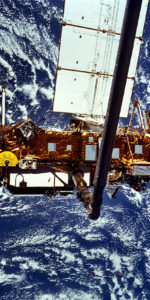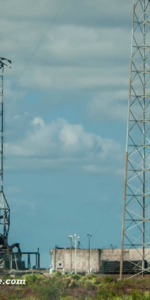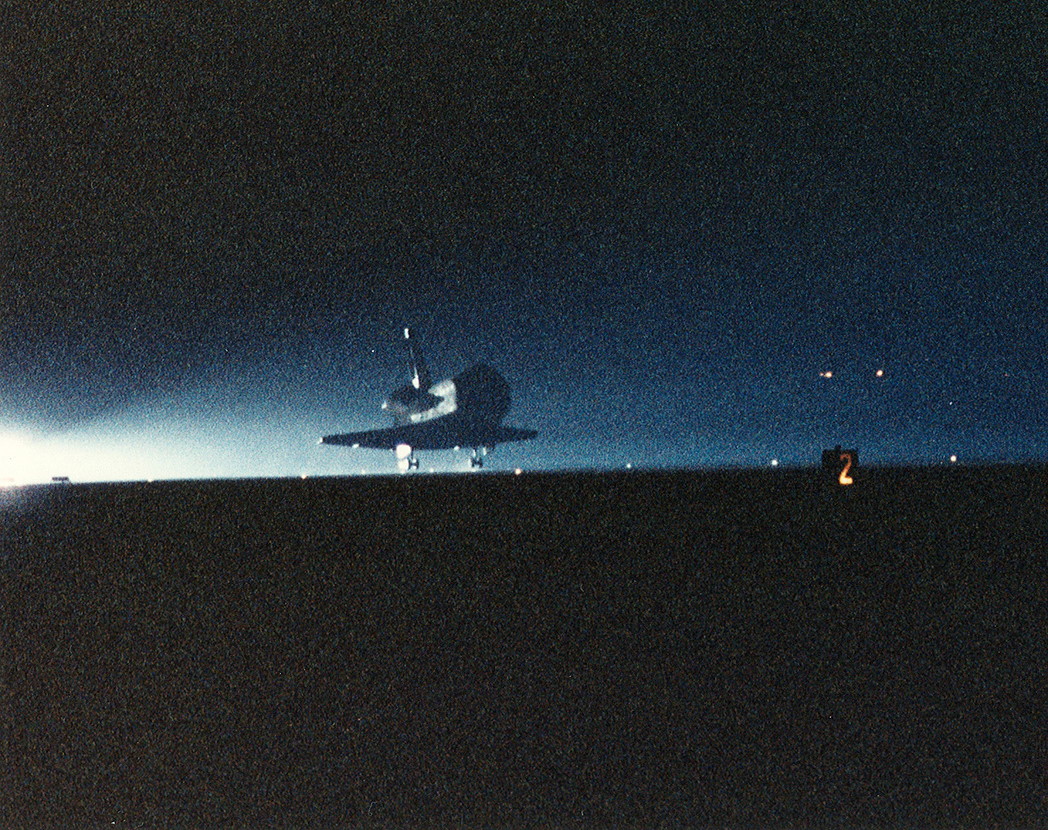
Late in September 2011, the skies above the Pacific Ocean were illuminated by an astonishing—though not unexpected—fire show. NASA’s 13,000-pound (5,900-kg) Upper Atmosphere Research Satellite (UARS), launched this week in September 1991, returned to Earth in a blaze of glowing debris, with the remnants splashing down in a remote stretch of the Pacific. Originally anticipated to operate for just two years, the UARS mission was extended several times and even when budget cuts forced it to be decommissioned in June 2005 no less than six of its nine instruments were still fully functional. Its eventual descent to Earth brought a rather high-profile closure to a mission which had proven instrumental in changing our perception of the Home Planet.
As described in yesterday’s AmericaSpace history article, the STS-48 mission to deploy UARS entered one of the highest orbits ever attained by the shuttle: 373 miles (600 km), which also represented the highest-altitude 57-degree-inclined orbit ever reached by the reusable spacecraft. This was just slightly less than the altitude of the Hubble Space Telescope (HST), which operated in a lower-inclination orbit of 28.45 degrees. “We set a world altitude record for a winged vehicle” at a 57-degree inclination, Commander John “J.O.” Creighton proudly said of STS-48, and to this day he retains the commemorative plaque in his office to prove it.
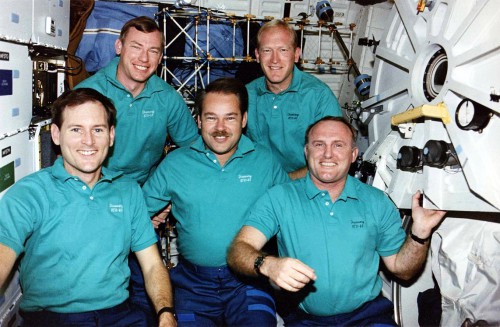
His crew aboard Shuttle Discovery—Pilot Ken Reightler and Mission Specialists Charles “Sam” Gemar, Jim Buchli, and Mark Brown—quickly set to work after their 12 September 1991 launch to prepare for five days of orbital activities. For Reightler, it was his first mission and his arrival in space brought with it the excitement faced by every first-time astronaut. Following orbital insertion, his time came to unbuckle from his seat in Discovery’s forward flight deck and float downstairs to the middeck to doff his bulky suit … and as soon as he did so, the view through the overhead windows arrested him. “The orbiter was inverted, flying over Asia,” he recalled in a 2001 interview for the Smithsonian, “so I was looking straight down at Earth. I was totally unprepared for the colors, textures, detail and vastness of the scene. It literally took my breath away. No amount of training or looking at slides and movies can prepare you for that moment.”
Yet there was work to do. UARS was one of the largest and heaviest shuttle payloads ever orbited and would be deployed by Mark Brown, using the Canadian-built Remote Manipulator System (RMS) mechanical arm. In anticipation of any problems, Buchli and Gemar were trained to perform a contingency Extravehicular Activity (EVA) and much of the second day of the mission was spent preparing space suits and lowering Discovery’s cabin pressure accordingly from 14.7 psi to 10.2 psi.
Deployment of UARS was accomplished at 12:23 a.m. EDT on 16 September. Its release came an orbit later than planned, due to the need to attend to a minor communications issue, but inaugurated a spectacular mission, whose results continued to reverberate to this day. “One of the things they saw,” Creighton told the oral historian, “is that the chloroflurocarbons that come from the industrialized northern hemisphere were migrating down over the Antarctic and that’s what was a direct correlation to what was causing the destruction of the ozone layer in the Antarctic spring. It would release all of these things that were trapped in the lower atmosphere and then it would spiral up, because of the circular wind patterns, up into the ozone and then create the “hole”. That was kind of exciting to see that what people had long suspected was proven.” For a mission devoted to atmospheric science, it proved somewhat serendipitous that Mount Pinatubo—a stratovolcano in the Cabusilan Mountains of the island of Luzon in the Phillippines—had erupted in June 1991, producing the 20th century’s second-largest terrestrial eruption.
The events surrounding the event were complicated by Typhoon Yunga, which added a lethal mixture of ash and rain, and although predictions led to the successful evacuation of tens of thousands of inhabitants from the disaster zone, Pinatubo stands as one of the most devastating environmental calamities in history. Earlier volcanic deposits were remobilized, infrastructure was destroyed wholesale, and river systems were significantly altered by the effects of huge amounts of magma, as well as volcanic dust which created an aerosol-rich layer of sulphuric acid haze in the stratosphere that spread around the world and lowered global temperatures by around half a degree Celsius.
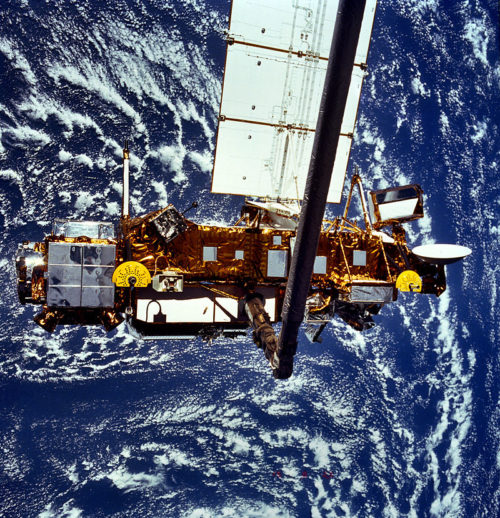
In the first few weeks after its deployment from Discovery, UARS’ instruments were directed to measure carbon dioxide emissions from the Pinatubo eruption. “And lo and behold,” said Creighton, “there was destruction of the ozone layer, right around the equator, because of the eruption of the volcano.” Over the next decade, UARS’s contributions to atmospheric and solar science were so significant that plans were even afoot for a shuttle mission, involving a single EVA, to either retrieve it or install new instruments. These plans never reached fruition and by September 2001 had been shelved by NASA.
STS-48 remained in orbit for five days and the astronauts were fully occupied by a battery of scientific, medical, and technical experiments. Investigations in protein crystal growth, muscular atrophy in rats, and polymer membranes were conducted, measurements of cosmic and gamma radiation were taken, and an intriguing demonstration of a model truss structure for Space Station Freedom was assembled in the middeck. This MIT-funded study, known as the Middeck Zero-Gravity Dynamics Experiment, or “MODE,” incorporated accelerometers and strain gauges to examine the behavior of truss members and the sloshing of fluids (represented in the test by water and silicon oil) and assess the performance of “rotary joints” to steer the station’s massive solar arrays.
For the first time, an Electronic Still Camera (ESC)—a modified Nikon F-4 35 mm camera, fitted with a charge-coupled device for digital image storage—was carried into space aboard the shuttle. It was primarily Mark Brown’s responsibility. Today, it is easy to take the real-time downlink capabilities of electronic still cameras for granted, but on STS-48 this was demonstrated for the first time. “The ability,” noted NASA’s pre-mission press kit, “is expected to greatly improve photo-documentation capabilities in Earth observations and on-board activity on the space shuttle, as well as future long-duration flights, such as Space Station Freedom or a human mission to Mars.”
For Creighton, the MODE tests were particularly memorable. “It was almost being a kid with a Tinker Toy set,” he recalled, “putting all those things back together again. We had a little shaker with a bunch of strain gauges on it to vibrate this structure to see how it would react in space. What they were trying to do is verify the computer models down on the ground to make sure that the vibration and the characteristics of this truss would react in space the way they thought they were predicting they would in computers … and that was successful.” NASA had been flying spacecraft for several decades, of course, but the behaviour of fluids in partially-empty propellant tanks under microgravity conditions was still imperfectly understood. MODE’s clear Plexiglas vials of water and silicon oil enabled the first detailed analyses to take place.
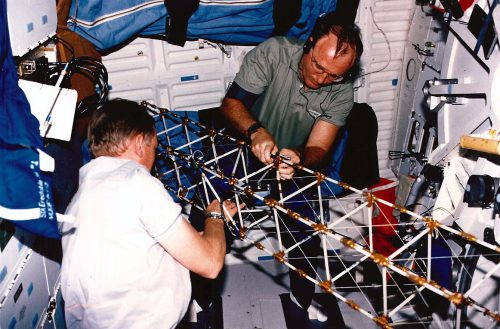
The mission briefly entered the news, early on 17 September, when it became the first shuttle flight to take evasive action to avoid a piece of space junk. Four days after launch, Mission Control advised the astronauts that their trajectory would carry them uncomfortably close to the Soviet Union’s car-sized Cosmos 955 satellite—perhaps as close as just 0.7 miles (1.2 km). “With the planned space station,” Mark Brown told journalists after the flight, “which will be less maneuverable than a shuttle, NASA will need to study the potential problem of collisions with debris much more carefully.” (These proved ironic words, considering the fact that in October 2010 the ISS crew performed an avoidance maneuver associated with the very same satellite, UARS, that Brown had deployed.)
A short, seven-second burn of Discovery’s Reaction Control System (RCS) thrusters established a 10-mile (16 km) berth between the crew and the defunct Cosmos 955, which had been in orbit for 14 years. “We were all busy conducting experiments,” Ken Reightler recalled, years later, “so no one gave this operation much time or attention. I didn’t even take a look out the window to see if I could see the intruder go by. I just wanted to make sure we didn’t make the news back home!”
For Reightler, his big event at the end of STS-48 was lowering the shuttle’s landing gear, a few seconds prior to touchdown … and that was something his wife, Maureen, constantly reminded him to do. Discovery’s 13th return from space was unusual in two ways: Firstly, it was only the second post-Challenger mission to have the Kennedy Space Center (KSC) as its scheduled landing site, and secondly, it would touch down, for the first time in Florida, in darkness. As a result, much of the astronauts’ re-entry training had been in darkness, crossing the darkened United States and alighting on a swamp-fringed runway. The actual event turned out to be somewhat different, when rain clouds in Florida forced a one-orbit extension to the mission and an eventual decision to land at Edwards Air Force Base, Calif. Creighton brought Discovery perfectly onto concrete Runway 22, in darkness, at 12:38 a.m. PDT (3:38 a.m. EDT) on 18 September, concluding a mission of just over five days.
As the orbiter’s wheels kissed the runway, the astronaut careers of three of the STS-48 crew came to an end. Mark Brown would work extensively on the early transition of the ailing Space Station Freedom into the ISS program, before retiring from NASA, whilst Creighton and Buchli would both depart the astronaut corps in mid-1992. “I could have stayed on and flown once or twice more,” Creighton told the oral historian, “but I wanted to get back up to the Northwest sooner or later.” His wife was completing her medical residency and the couple moved to Seattle, Wash., where Creighton took a position with Boeing as a production test pilot and instructor. Buchli, too, entered Boeing, but remained in space circles, as manager of Space Station Systems Operations and Requirements within the corporation’s Defense and Space Group in Huntsville, Ala. Ken Reightler and Sam Gemar would each fly one more shuttle mission apiece, later in their careers.
This is part of a series of history articles, which will appear each weekend, barring any major news stories. Next week’s article will focus on the 20th anniversary of STS-79, the fourth shuttle-Mir docking flight in September 1996, which exchanged U.S. crew members aboard the Russian space station.
Want to keep up-to-date with all things space? Be sure to “Like” AmericaSpace on Facebook and follow us on Twitter: @AmericaSpace




